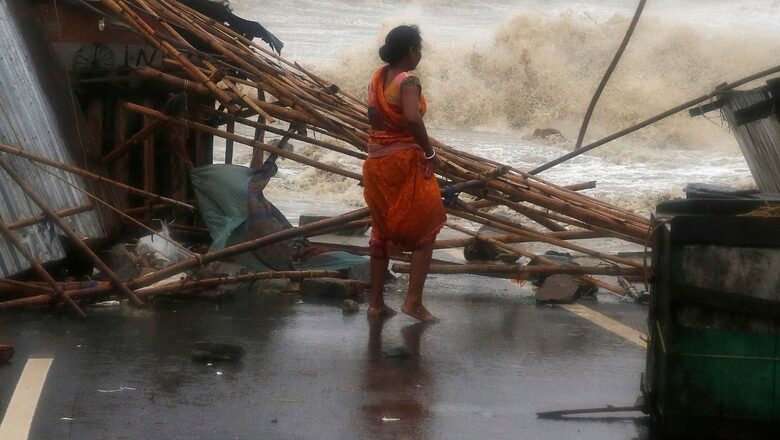
views
Odisha has encountered 10 cyclones, including the approaching Jawad, in a span of 22 years and the frequency of such natural disasters is only on the rise, official records of the State Disaster Management Authority (OSDMA) showed.
Here’s a list of major cyclones that have hit Odisha’s shores in the past two decades:
1999 Super Cyclone
Memories of the 1999 super cyclone is still fresh, wind speed of which could not be properly ascertained at the meteorological centre, Bhubaneswar, as the velocity crossed the capacity of the anemometer available then. The ‘Very Severe Cyclonic Storm’ left over 10,000 people dead. After the severe storm, the state had experienced another major calamity in cyclone Phailin.
Cyclone Phailin
Cyclone Phailin made landfall near Gopalpur in Ganjam district on October 12, 2013, becoming the second strongest tropical cyclone in India since 1999. It had hit Odisha at a wind speed of 140 mph leading to more than 550,000 people to move from the coastal to interior and safer regions. Twenty-three people were killed in the cyclonic storm after the Naveen Patnaik government set a “Zero Casualty” mission with precautionary measures in place, the records stated.
Cyclone Hudhud
Phailin was followed by cyclone Hudhud in 2014 that struck the Visakhapatnam city of Andhra Pradesh on October 12, 2014. Odisha, too, was affected by Hudhud. The ‘extremely severe’ category cyclonic storm left more than 60 people dead in Andhra Pradesh. Southern Odisha experienced heavy rainfall and wind speeds of about 90 kmph and the casualty count in the state was two.
Cyclone Titli
Subsequently, cyclone Titli in 2018 had left authorities in shock, as the weather system had unexpectedly changed its course and entered Gajapati district, where no major preparations were made to deal with the calamity. About 3,00,000 people were evacuated from low-lying districts and 77 people were killed in Odisha due to heavy rainfall and landslide that accompanied the cyclone.
Cyclones Fani and Bulbul
In the year that followed, two cyclones Fani and Bulbul — hit the country’s eastern coast, causing extensive damage in Odisha and West Bengal. Fani had reached its peak intensity a day before its landfall and reached its peak intensity on 2 May 2019. It was marked as a high-end Category-4 major hurricane, with maximum sustained wind speed ranging from 209-251 kmph. The storm killed 64 people in the state and adversely affected electricity supply and telecommunication.
Very Severe Cyclonic Storm Bulbul struck the eastern state in November 2019. The storm led to Odisha suffering agricultural damage, with 490,000 acres worth of crops destroyed state-wide. Two people also lost their lives in the storm.
Cyclone Amphan
Cyclone Amphan in 2020 had also claimed lives and damaged property in Odisha and West Bengal. It made landfall near Bakkhali in West Bengal on May 20. It was the first pre-monsoon super cyclone of this century that emerged from the Bay of Bengal. The Odisha government had said that the storm had affected over 44.45 lakh people in 9833 villages and 22 urban bodies.
According to United Nations report, titled State of the Global Climate 2020, Amphan was the “costliest tropical cyclone on record for the North Indian Ocean”, resulting in the country sustaining losses worth $14 billion.
Cyclone Yaas
In May this year, Cyclone Yaas hit Odisha’s Dhamra and left two people dead. The severe cyclonic storm made landfall in Odisha’s Balasore district on the morning of 26 May 2021, affecting 60 lakh people in 11,000 villages and caused financial losses to the tune of Rs 610 crore.
Cyclone Gulab
Shortly after, in September, cyclone Gulab crossed the Odisha-Andhra Pradesh coast, bringing with it heavy rain. The remnants of Cyclone Gulab then gave rise to Cyclone Shaheen, in a unique weather phenomenon. The name Shaheen was given by Qatar. Gulab was proposed by Pakistan. More than 20 people across different states and neighbouring countries died in cyclone Gulab. No death, however, was reported in Odisha, records showed.
Cyclone Jawad
Odisha is currently bracing for cyclone Jawad, which is being considered as the first winter cyclone in the state in about 100 years. The system has, however, weakened and may even escape its coast.
The former director of Regional Meteorological Centre, Bhubaneswar, Sarat C Sahu, stated that climate change was a major factor for increase in frequency of cyclones. “When sea temperature touches 26.5 degrees celsius or more, it helps a low pressure intensify. This time, in case of Jawad, the sea water temperature was 29 degree celsius. Besides sea pollution could also be another factor that creates an atmosphere suitable for formation of a cyclone,” he added.
Union minister Piyush Goyal reviewed the arrangements and preparations made by state governments of Andhra Pradesh, Odisha and West Bengal to deal with cyclone Jawad. The minister underscored the need for drawing of a comprehensive action plan towards managing this natural disaster in the most effective way by incorporating the inputs and suggestions of all stakeholders.
Goyal said public private partnership is necessary for disaster management and mitigation and for protecting the lives and livelihoods of those affected. “We must constantly upgrade our learnings and keep upgrading our capabilities. He also called for preparedness in the banking and insurance sectors to tackle the effects of the cyclone,” an official statement said.
(With inputs from agencies)
Read all the Latest India News here


















Comments
0 comment